Comprehensive Report: Collective Bargaining, Drug Testing, and NLRB
VerifiedAdded on 2023/04/23
|5
|1128
|184
Report
AI Summary
This report provides an analysis of collective bargaining, focusing on employee drug testing programs and the legal considerations involved, particularly for potential and current employees. It discusses the importance of probable cause for testing, valid testing procedures, and informing employees of the consequences of non-compliance. The report also covers the role of the National Labor Relations Board (NLRB) and the National Labor Relations Act in protecting employee rights and addressing workplace discrimination, including pay disparities based on gender or other factors. The report highlights the legality of pre-employment drug testing and the steps involved in the drug screening process, emphasizing the importance of fairness and adherence to regulations. The report references key legal and regulatory frameworks, emphasizing the importance of fair treatment in the workplace and the role of the NLRB in resolving labor disputes and overseeing union elections.
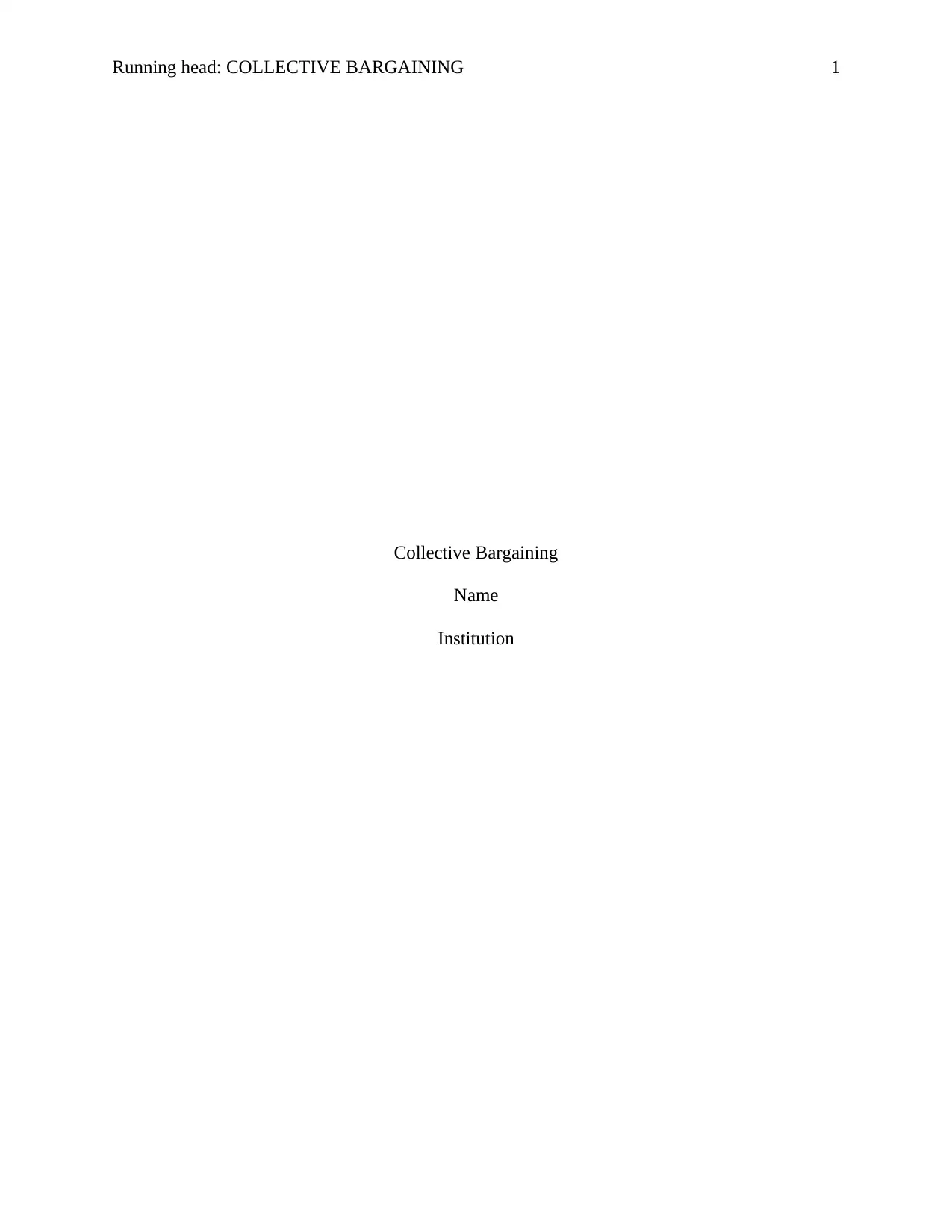
Running head: COLLECTIVE BARGAINING 1
Collective Bargaining
Name
Institution
Collective Bargaining
Name
Institution
Paraphrase This Document
Need a fresh take? Get an instant paraphrase of this document with our AI Paraphraser
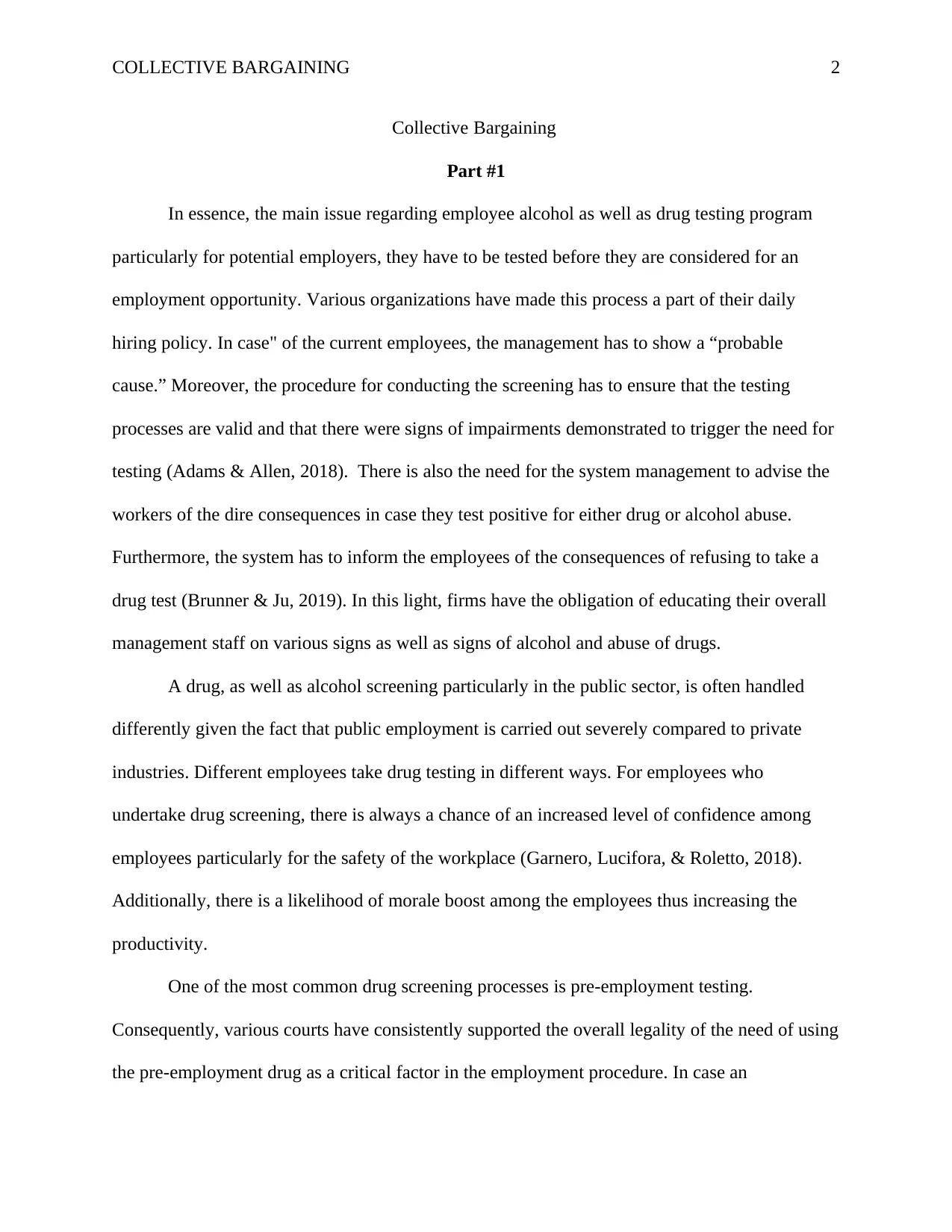
COLLECTIVE BARGAINING 2
Collective Bargaining
Part #1
In essence, the main issue regarding employee alcohol as well as drug testing program
particularly for potential employers, they have to be tested before they are considered for an
employment opportunity. Various organizations have made this process a part of their daily
hiring policy. In case" of the current employees, the management has to show a “probable
cause.” Moreover, the procedure for conducting the screening has to ensure that the testing
processes are valid and that there were signs of impairments demonstrated to trigger the need for
testing (Adams & Allen, 2018). There is also the need for the system management to advise the
workers of the dire consequences in case they test positive for either drug or alcohol abuse.
Furthermore, the system has to inform the employees of the consequences of refusing to take a
drug test (Brunner & Ju, 2019). In this light, firms have the obligation of educating their overall
management staff on various signs as well as signs of alcohol and abuse of drugs.
A drug, as well as alcohol screening particularly in the public sector, is often handled
differently given the fact that public employment is carried out severely compared to private
industries. Different employees take drug testing in different ways. For employees who
undertake drug screening, there is always a chance of an increased level of confidence among
employees particularly for the safety of the workplace (Garnero, Lucifora, & Roletto, 2018).
Additionally, there is a likelihood of morale boost among the employees thus increasing the
productivity.
One of the most common drug screening processes is pre-employment testing.
Consequently, various courts have consistently supported the overall legality of the need of using
the pre-employment drug as a critical factor in the employment procedure. In case an
Collective Bargaining
Part #1
In essence, the main issue regarding employee alcohol as well as drug testing program
particularly for potential employers, they have to be tested before they are considered for an
employment opportunity. Various organizations have made this process a part of their daily
hiring policy. In case" of the current employees, the management has to show a “probable
cause.” Moreover, the procedure for conducting the screening has to ensure that the testing
processes are valid and that there were signs of impairments demonstrated to trigger the need for
testing (Adams & Allen, 2018). There is also the need for the system management to advise the
workers of the dire consequences in case they test positive for either drug or alcohol abuse.
Furthermore, the system has to inform the employees of the consequences of refusing to take a
drug test (Brunner & Ju, 2019). In this light, firms have the obligation of educating their overall
management staff on various signs as well as signs of alcohol and abuse of drugs.
A drug, as well as alcohol screening particularly in the public sector, is often handled
differently given the fact that public employment is carried out severely compared to private
industries. Different employees take drug testing in different ways. For employees who
undertake drug screening, there is always a chance of an increased level of confidence among
employees particularly for the safety of the workplace (Garnero, Lucifora, & Roletto, 2018).
Additionally, there is a likelihood of morale boost among the employees thus increasing the
productivity.
One of the most common drug screening processes is pre-employment testing.
Consequently, various courts have consistently supported the overall legality of the need of using
the pre-employment drug as a critical factor in the employment procedure. In case an
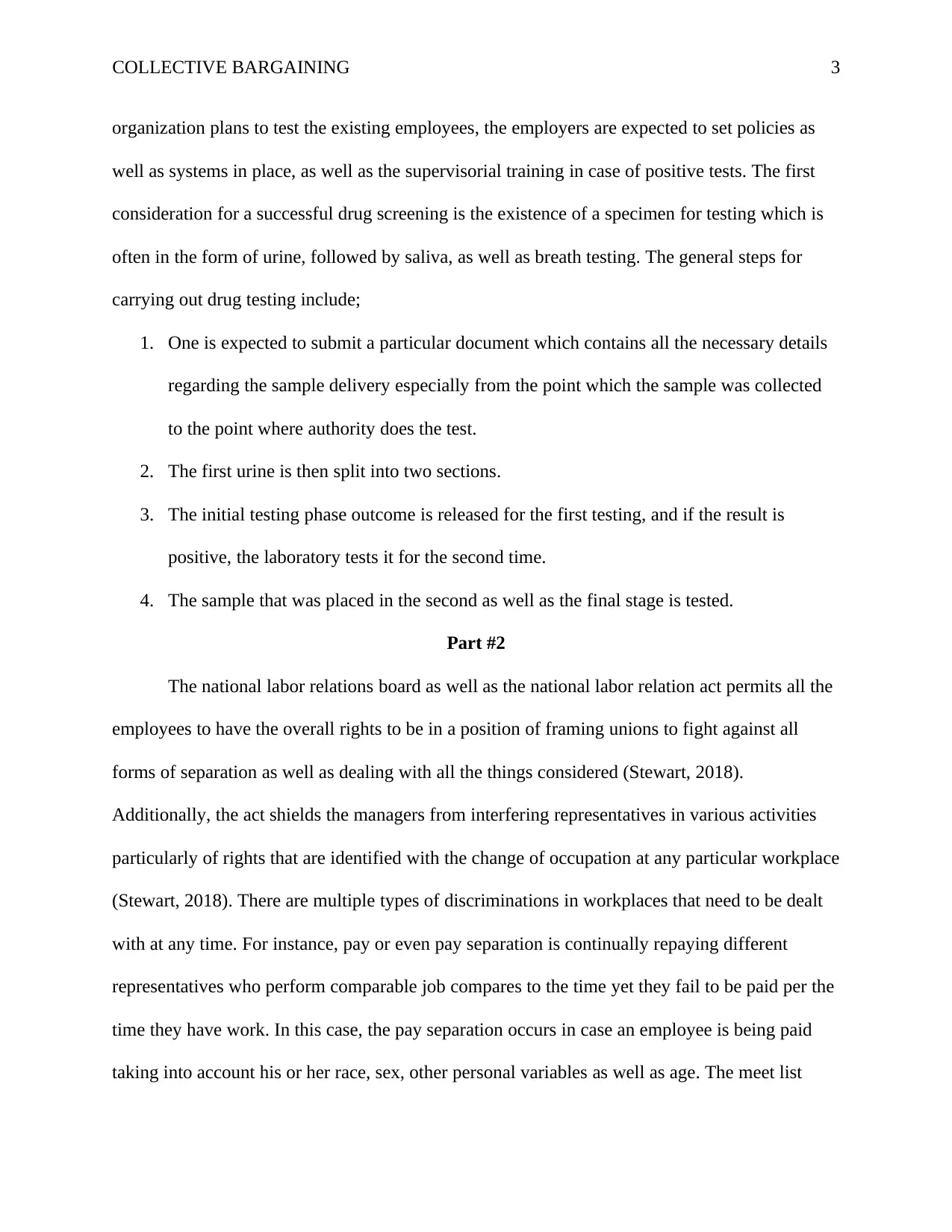
COLLECTIVE BARGAINING 3
organization plans to test the existing employees, the employers are expected to set policies as
well as systems in place, as well as the supervisorial training in case of positive tests. The first
consideration for a successful drug screening is the existence of a specimen for testing which is
often in the form of urine, followed by saliva, as well as breath testing. The general steps for
carrying out drug testing include;
1. One is expected to submit a particular document which contains all the necessary details
regarding the sample delivery especially from the point which the sample was collected
to the point where authority does the test.
2. The first urine is then split into two sections.
3. The initial testing phase outcome is released for the first testing, and if the result is
positive, the laboratory tests it for the second time.
4. The sample that was placed in the second as well as the final stage is tested.
Part #2
The national labor relations board as well as the national labor relation act permits all the
employees to have the overall rights to be in a position of framing unions to fight against all
forms of separation as well as dealing with all the things considered (Stewart, 2018).
Additionally, the act shields the managers from interfering representatives in various activities
particularly of rights that are identified with the change of occupation at any particular workplace
(Stewart, 2018). There are multiple types of discriminations in workplaces that need to be dealt
with at any time. For instance, pay or even pay separation is continually repaying different
representatives who perform comparable job compares to the time yet they fail to be paid per the
time they have work. In this case, the pay separation occurs in case an employee is being paid
taking into account his or her race, sex, other personal variables as well as age. The meet list
organization plans to test the existing employees, the employers are expected to set policies as
well as systems in place, as well as the supervisorial training in case of positive tests. The first
consideration for a successful drug screening is the existence of a specimen for testing which is
often in the form of urine, followed by saliva, as well as breath testing. The general steps for
carrying out drug testing include;
1. One is expected to submit a particular document which contains all the necessary details
regarding the sample delivery especially from the point which the sample was collected
to the point where authority does the test.
2. The first urine is then split into two sections.
3. The initial testing phase outcome is released for the first testing, and if the result is
positive, the laboratory tests it for the second time.
4. The sample that was placed in the second as well as the final stage is tested.
Part #2
The national labor relations board as well as the national labor relation act permits all the
employees to have the overall rights to be in a position of framing unions to fight against all
forms of separation as well as dealing with all the things considered (Stewart, 2018).
Additionally, the act shields the managers from interfering representatives in various activities
particularly of rights that are identified with the change of occupation at any particular workplace
(Stewart, 2018). There are multiple types of discriminations in workplaces that need to be dealt
with at any time. For instance, pay or even pay separation is continually repaying different
representatives who perform comparable job compares to the time yet they fail to be paid per the
time they have work. In this case, the pay separation occurs in case an employee is being paid
taking into account his or her race, sex, other personal variables as well as age. The meet list
⊘ This is a preview!⊘
Do you want full access?
Subscribe today to unlock all pages.

Trusted by 1+ million students worldwide
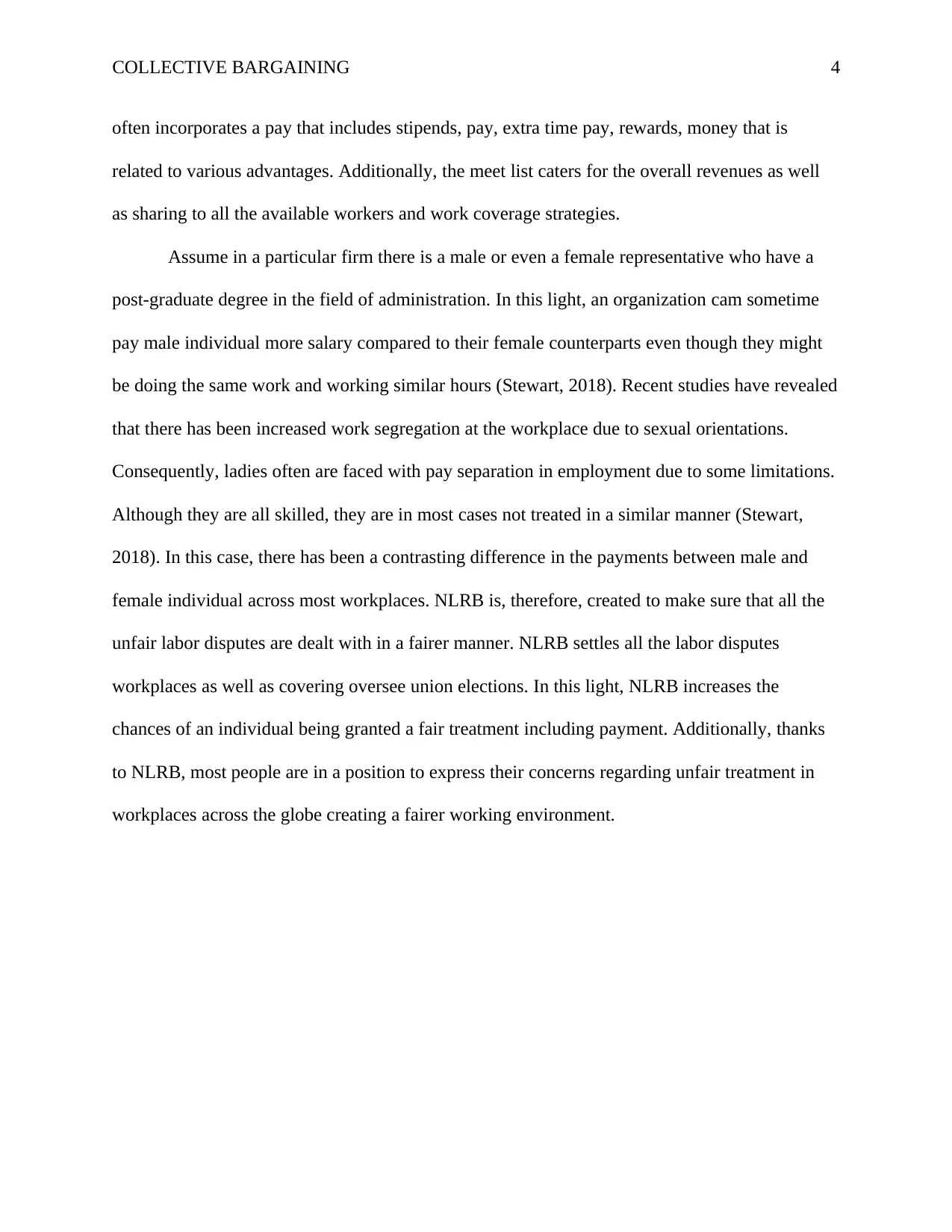
COLLECTIVE BARGAINING 4
often incorporates a pay that includes stipends, pay, extra time pay, rewards, money that is
related to various advantages. Additionally, the meet list caters for the overall revenues as well
as sharing to all the available workers and work coverage strategies.
Assume in a particular firm there is a male or even a female representative who have a
post-graduate degree in the field of administration. In this light, an organization cam sometime
pay male individual more salary compared to their female counterparts even though they might
be doing the same work and working similar hours (Stewart, 2018). Recent studies have revealed
that there has been increased work segregation at the workplace due to sexual orientations.
Consequently, ladies often are faced with pay separation in employment due to some limitations.
Although they are all skilled, they are in most cases not treated in a similar manner (Stewart,
2018). In this case, there has been a contrasting difference in the payments between male and
female individual across most workplaces. NLRB is, therefore, created to make sure that all the
unfair labor disputes are dealt with in a fairer manner. NLRB settles all the labor disputes
workplaces as well as covering oversee union elections. In this light, NLRB increases the
chances of an individual being granted a fair treatment including payment. Additionally, thanks
to NLRB, most people are in a position to express their concerns regarding unfair treatment in
workplaces across the globe creating a fairer working environment.
often incorporates a pay that includes stipends, pay, extra time pay, rewards, money that is
related to various advantages. Additionally, the meet list caters for the overall revenues as well
as sharing to all the available workers and work coverage strategies.
Assume in a particular firm there is a male or even a female representative who have a
post-graduate degree in the field of administration. In this light, an organization cam sometime
pay male individual more salary compared to their female counterparts even though they might
be doing the same work and working similar hours (Stewart, 2018). Recent studies have revealed
that there has been increased work segregation at the workplace due to sexual orientations.
Consequently, ladies often are faced with pay separation in employment due to some limitations.
Although they are all skilled, they are in most cases not treated in a similar manner (Stewart,
2018). In this case, there has been a contrasting difference in the payments between male and
female individual across most workplaces. NLRB is, therefore, created to make sure that all the
unfair labor disputes are dealt with in a fairer manner. NLRB settles all the labor disputes
workplaces as well as covering oversee union elections. In this light, NLRB increases the
chances of an individual being granted a fair treatment including payment. Additionally, thanks
to NLRB, most people are in a position to express their concerns regarding unfair treatment in
workplaces across the globe creating a fairer working environment.
Paraphrase This Document
Need a fresh take? Get an instant paraphrase of this document with our AI Paraphraser
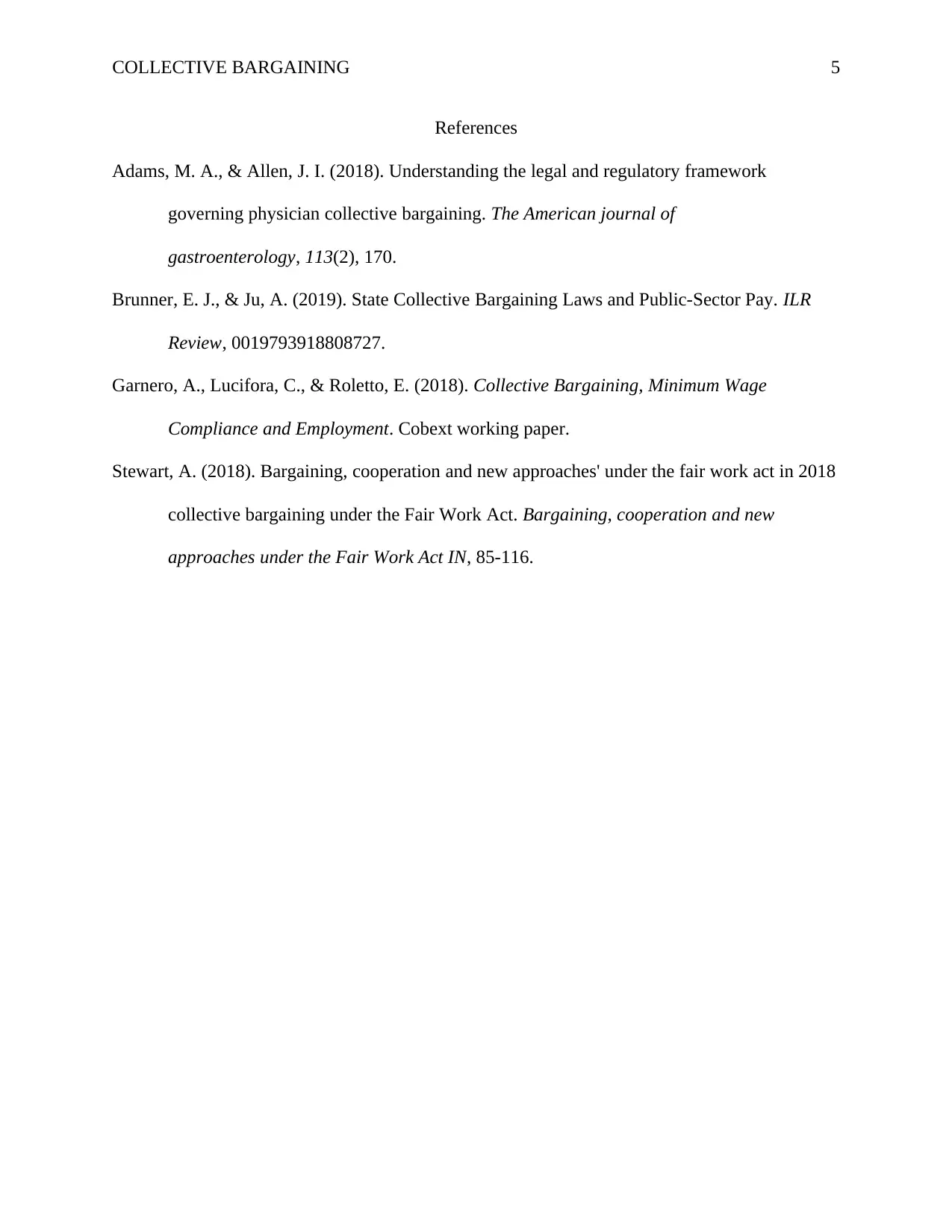
COLLECTIVE BARGAINING 5
References
Adams, M. A., & Allen, J. I. (2018). Understanding the legal and regulatory framework
governing physician collective bargaining. The American journal of
gastroenterology, 113(2), 170.
Brunner, E. J., & Ju, A. (2019). State Collective Bargaining Laws and Public-Sector Pay. ILR
Review, 0019793918808727.
Garnero, A., Lucifora, C., & Roletto, E. (2018). Collective Bargaining, Minimum Wage
Compliance and Employment. Cobext working paper.
Stewart, A. (2018). Bargaining, cooperation and new approaches' under the fair work act in 2018
collective bargaining under the Fair Work Act. Bargaining, cooperation and new
approaches under the Fair Work Act IN, 85-116.
References
Adams, M. A., & Allen, J. I. (2018). Understanding the legal and regulatory framework
governing physician collective bargaining. The American journal of
gastroenterology, 113(2), 170.
Brunner, E. J., & Ju, A. (2019). State Collective Bargaining Laws and Public-Sector Pay. ILR
Review, 0019793918808727.
Garnero, A., Lucifora, C., & Roletto, E. (2018). Collective Bargaining, Minimum Wage
Compliance and Employment. Cobext working paper.
Stewart, A. (2018). Bargaining, cooperation and new approaches' under the fair work act in 2018
collective bargaining under the Fair Work Act. Bargaining, cooperation and new
approaches under the Fair Work Act IN, 85-116.
1 out of 5
Related Documents
Your All-in-One AI-Powered Toolkit for Academic Success.
+13062052269
info@desklib.com
Available 24*7 on WhatsApp / Email
![[object Object]](/_next/static/media/star-bottom.7253800d.svg)
Unlock your academic potential
Copyright © 2020–2025 A2Z Services. All Rights Reserved. Developed and managed by ZUCOL.





